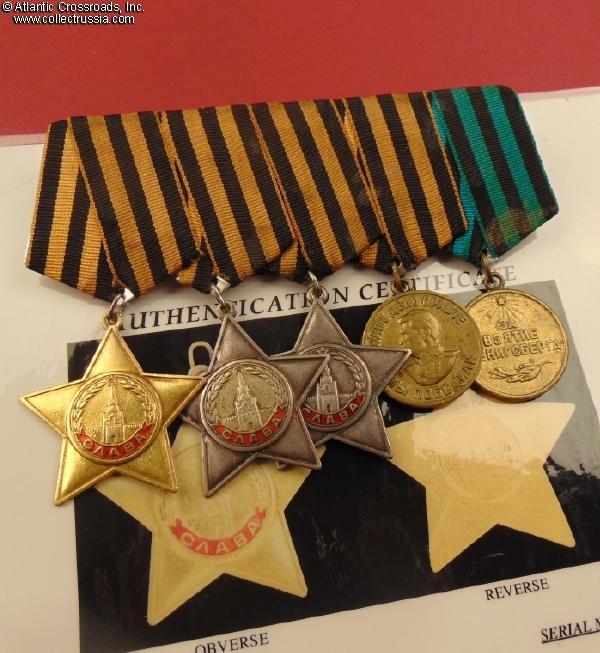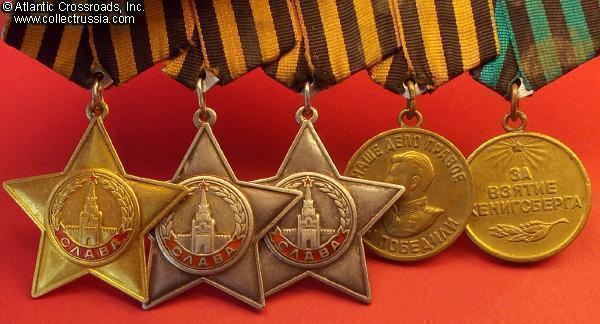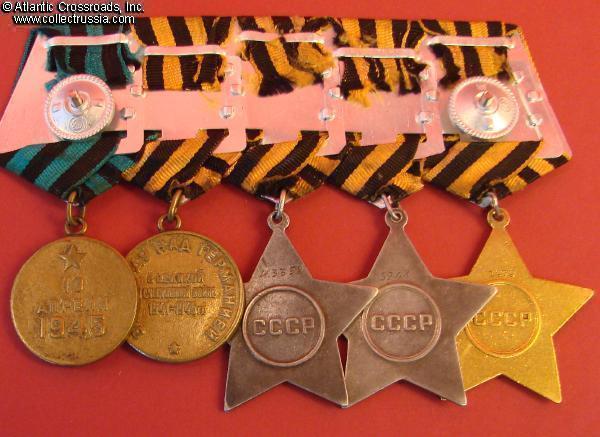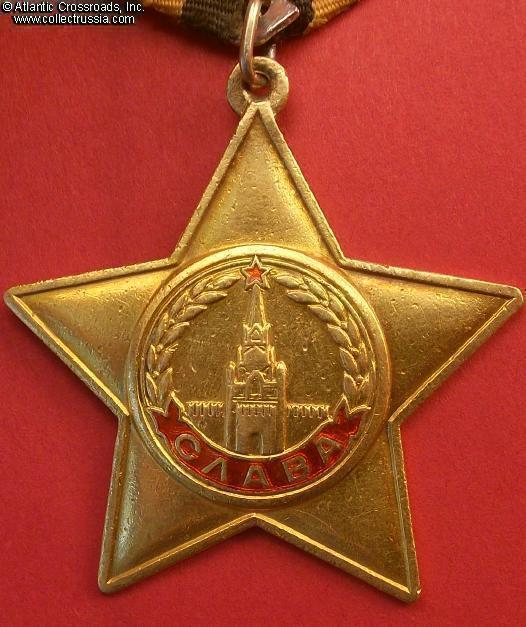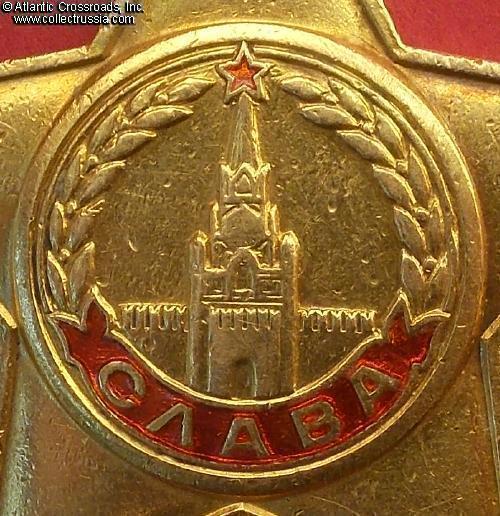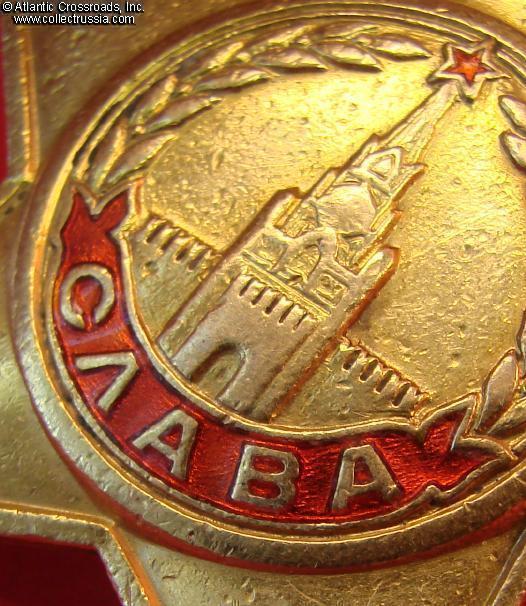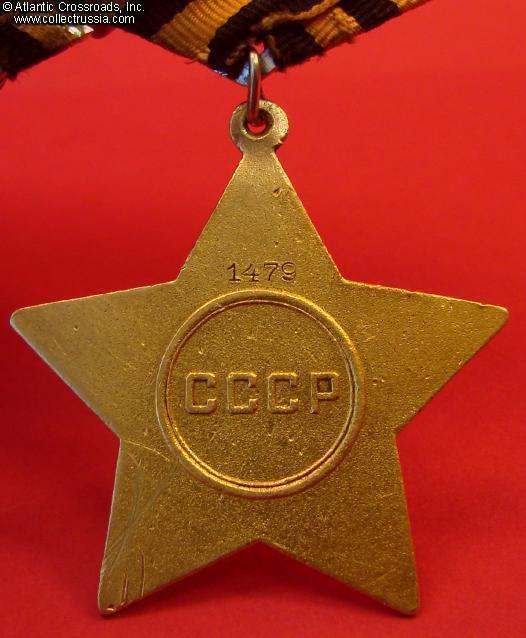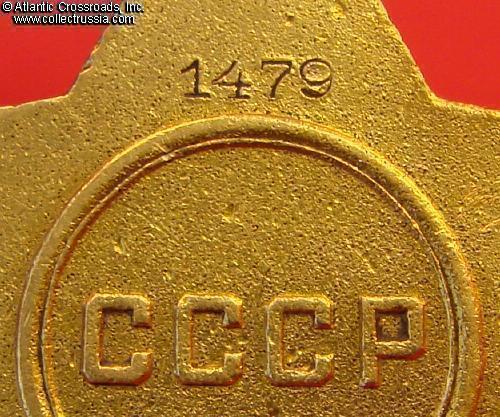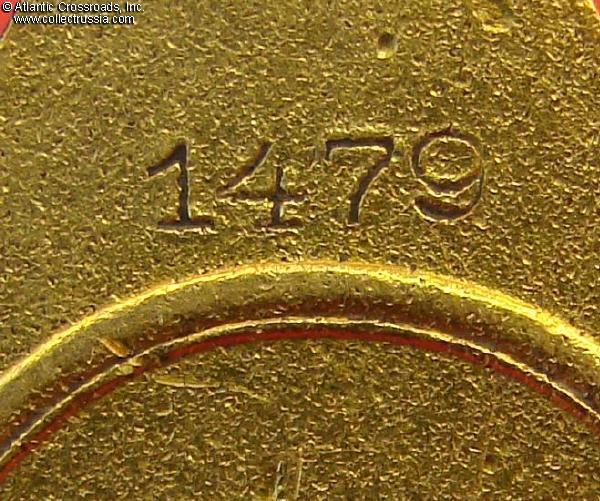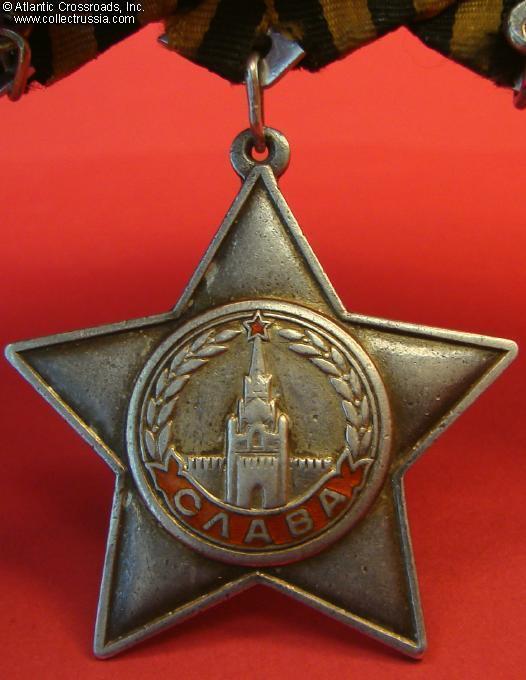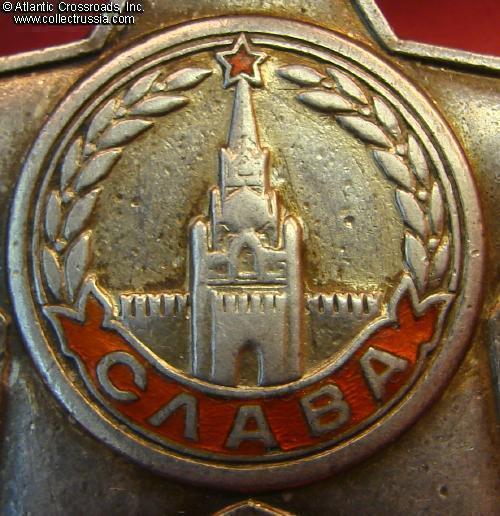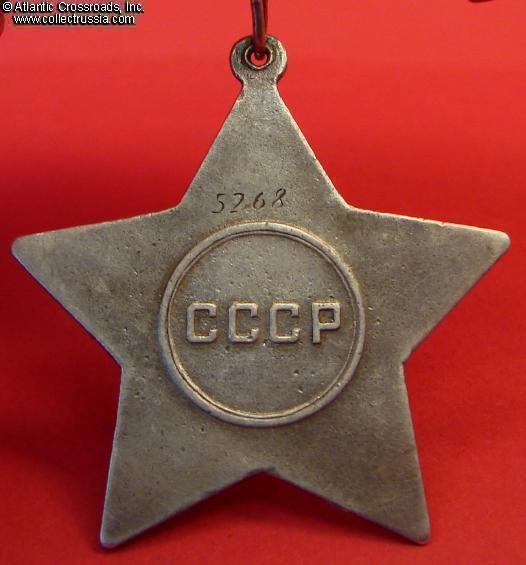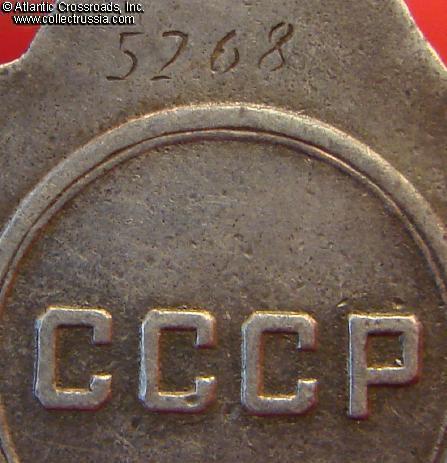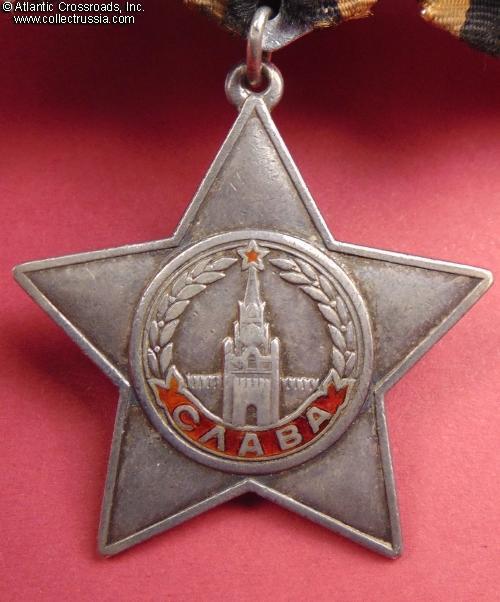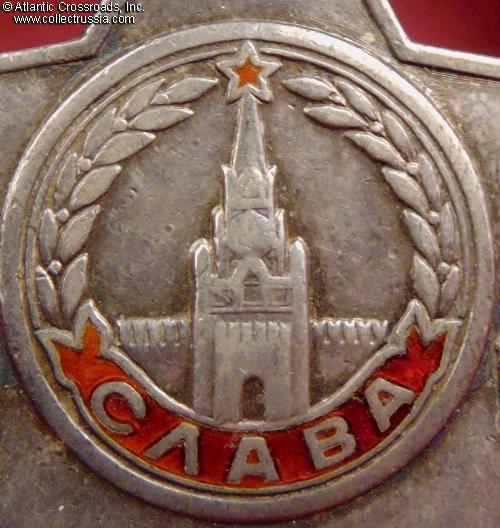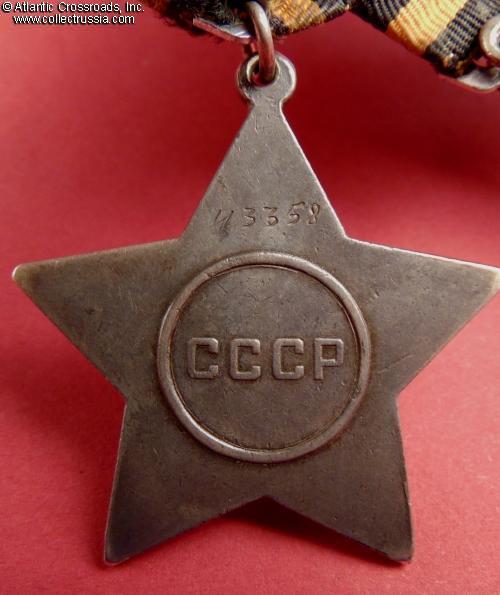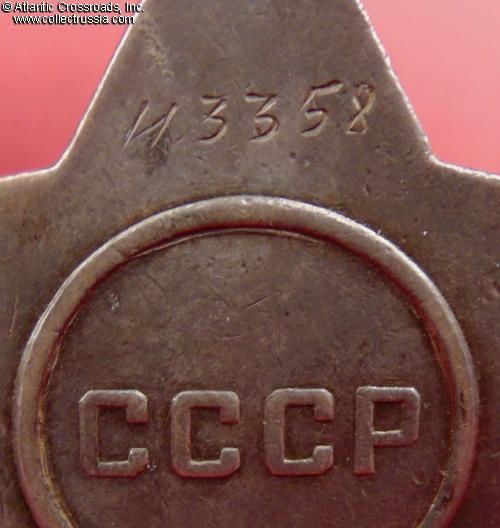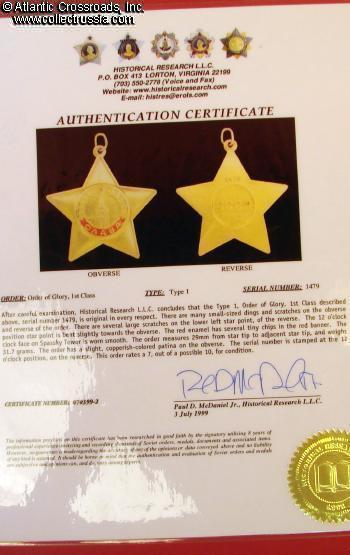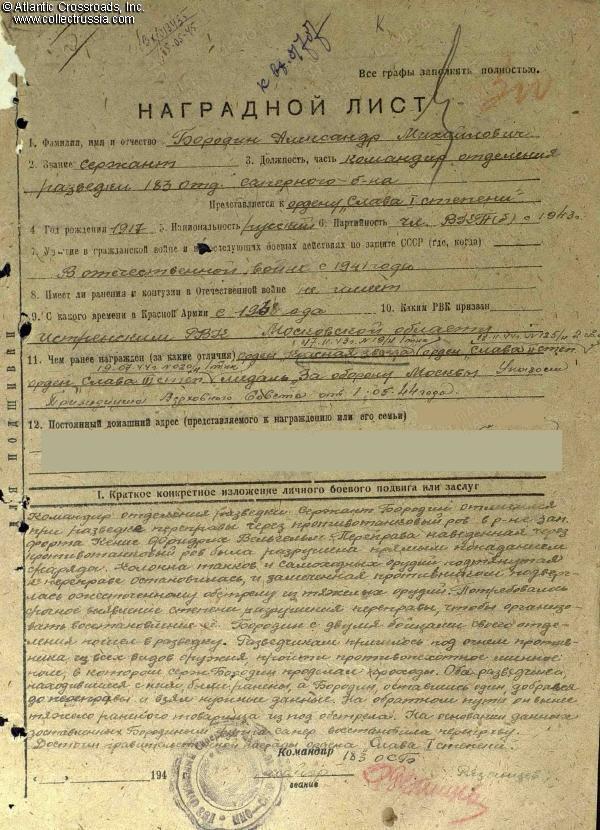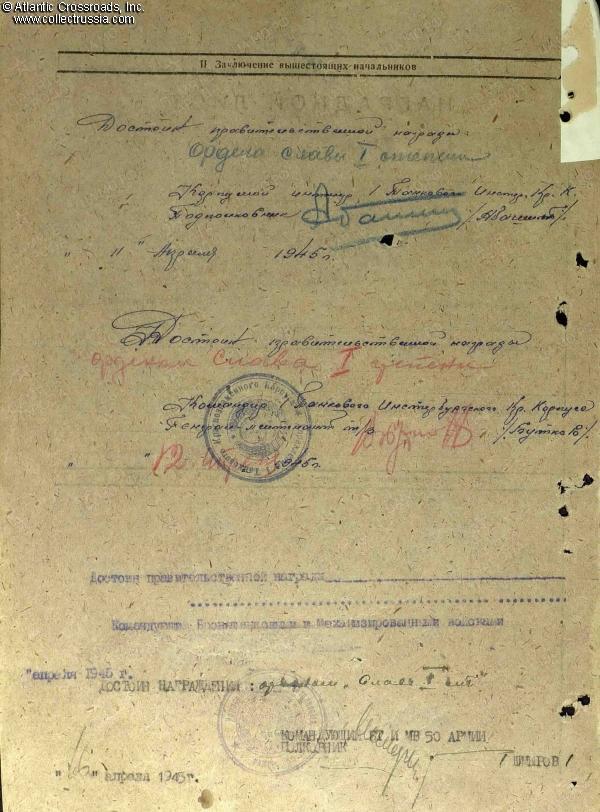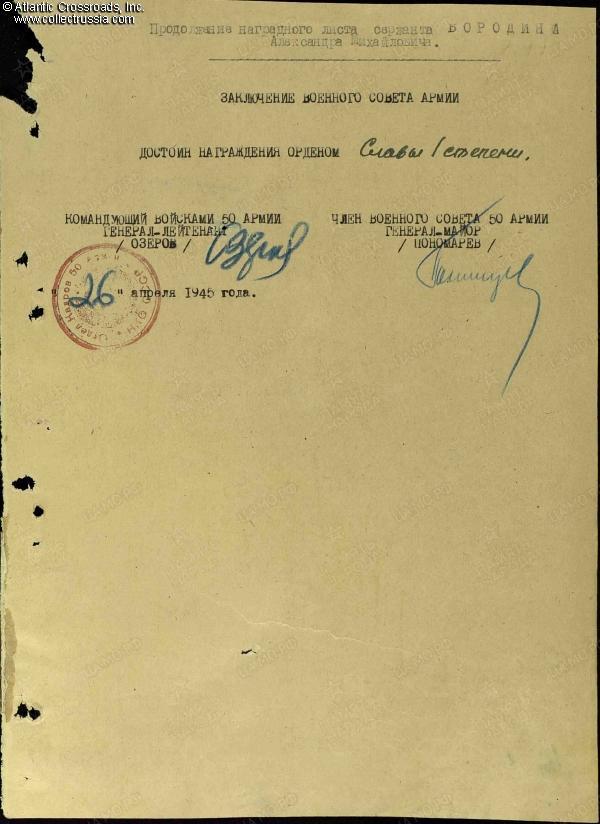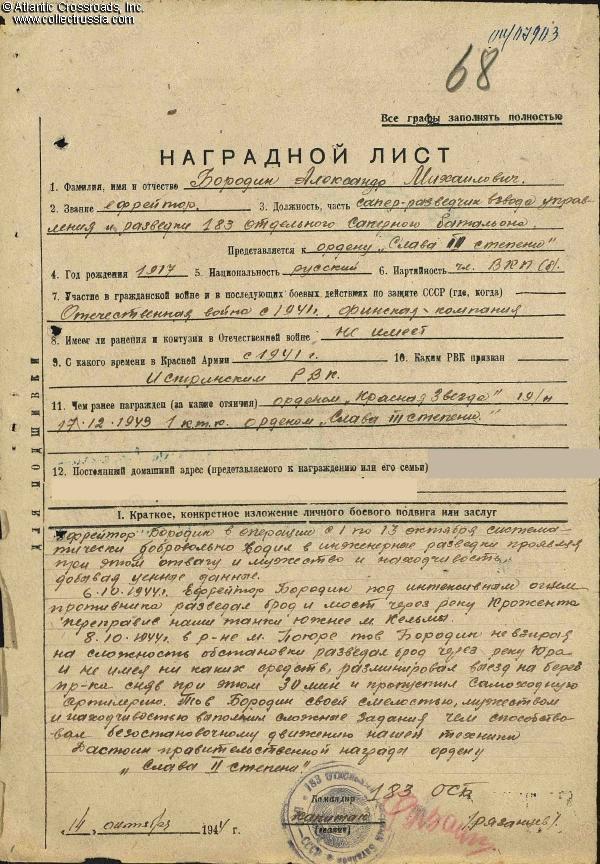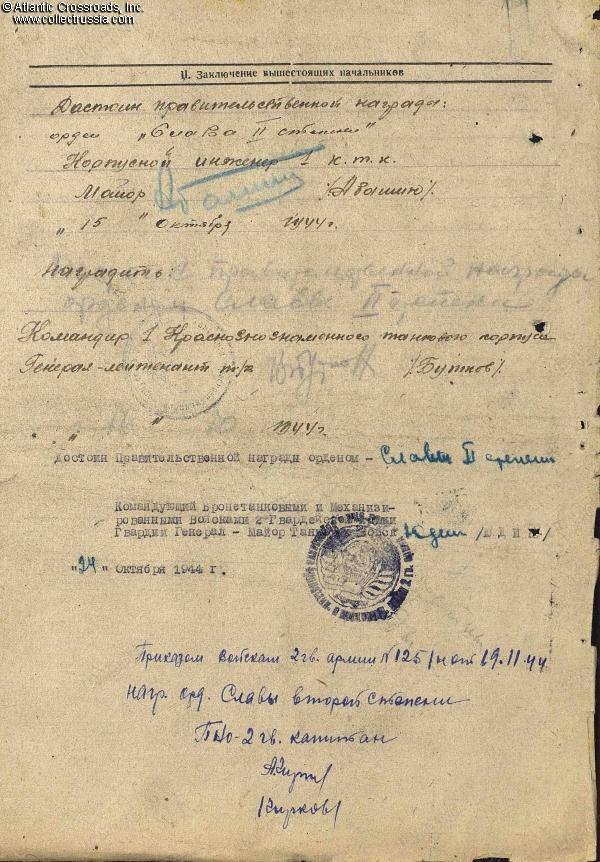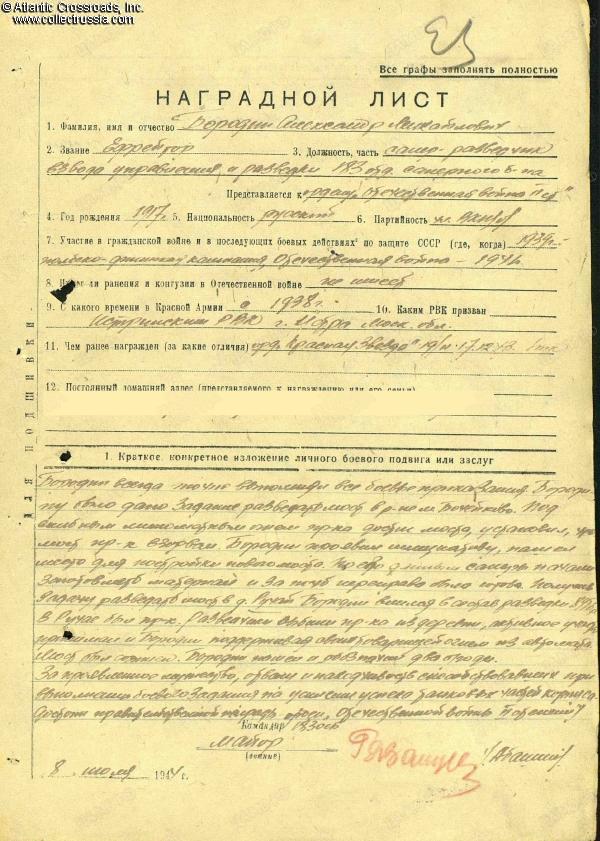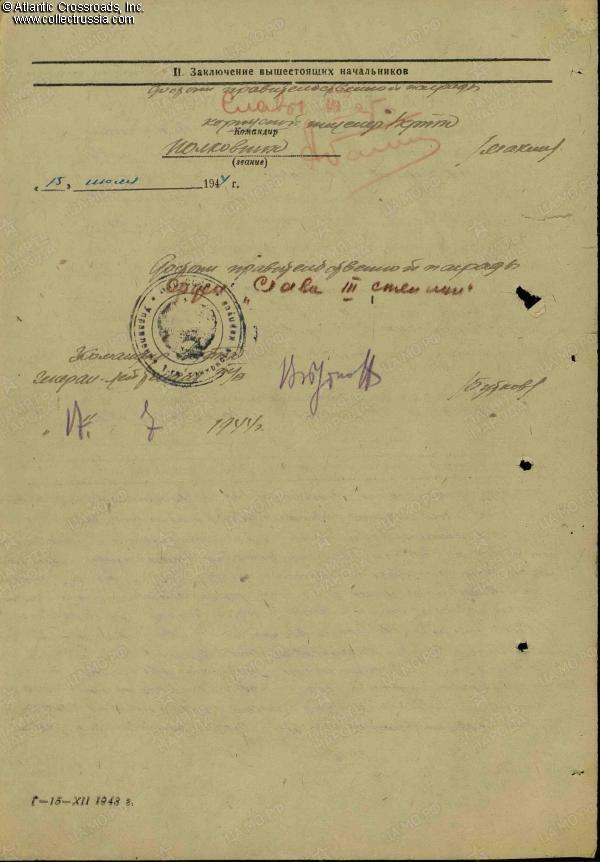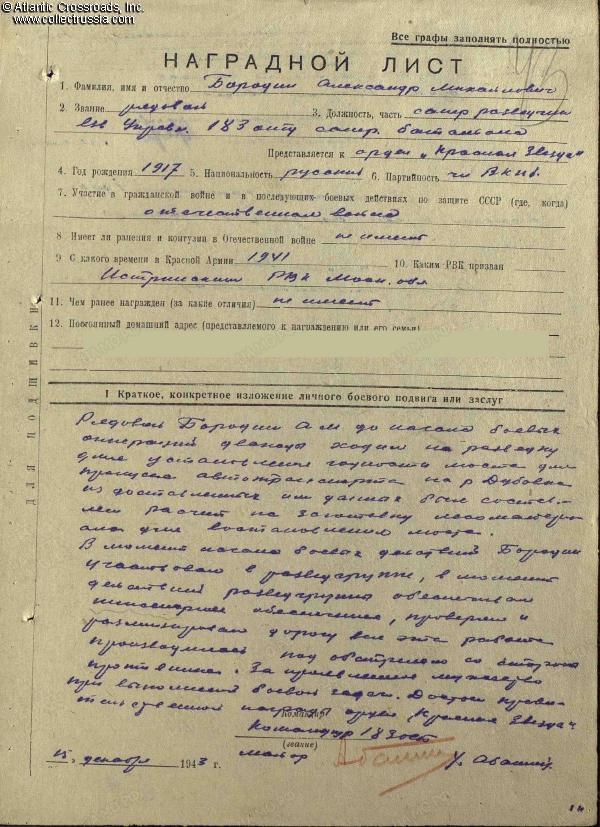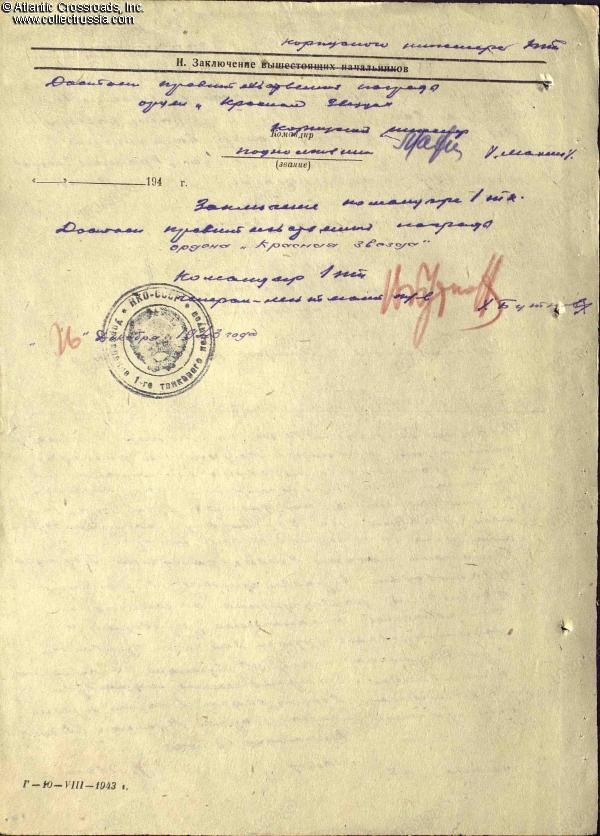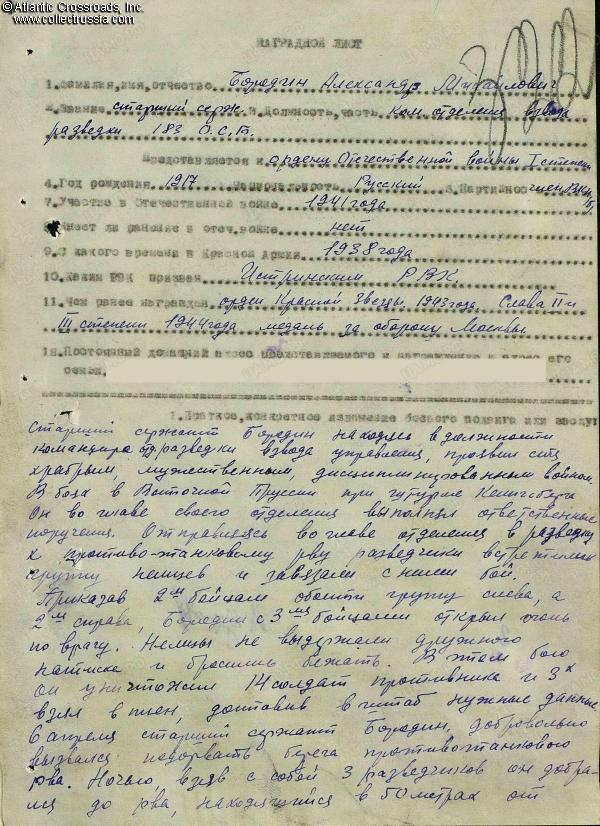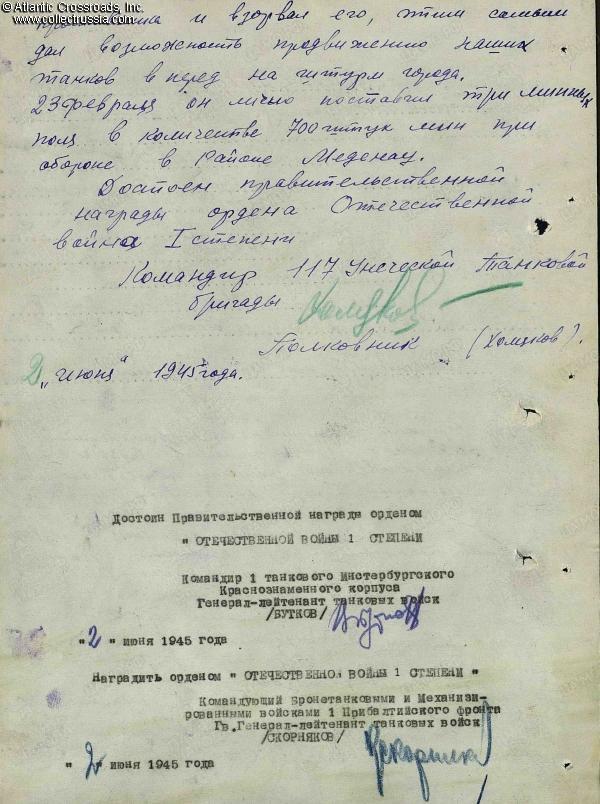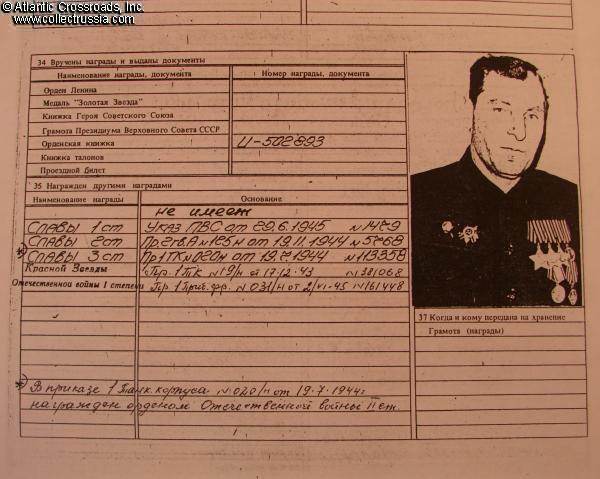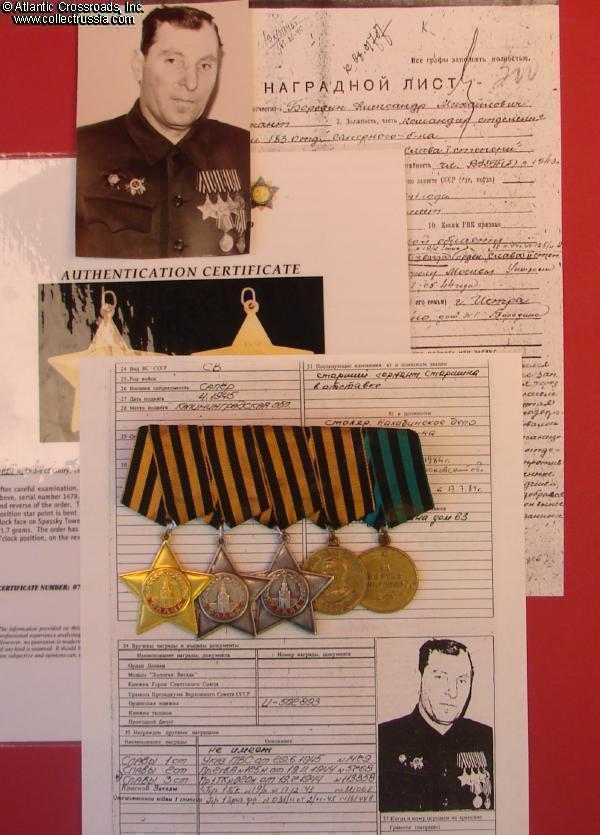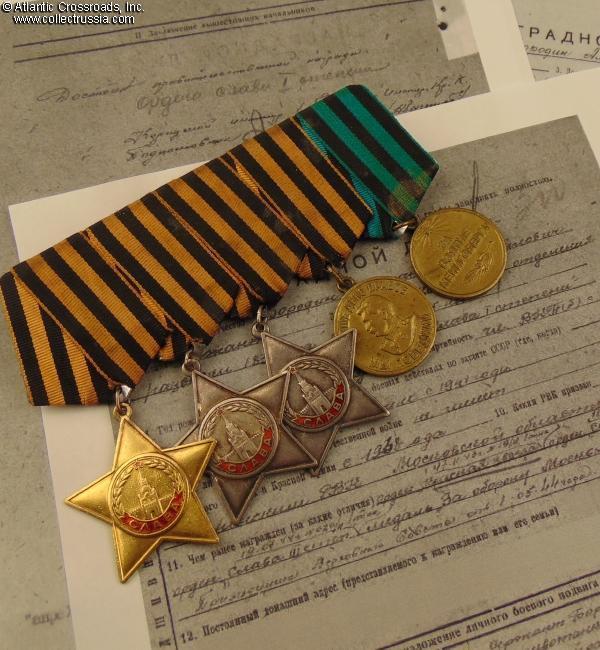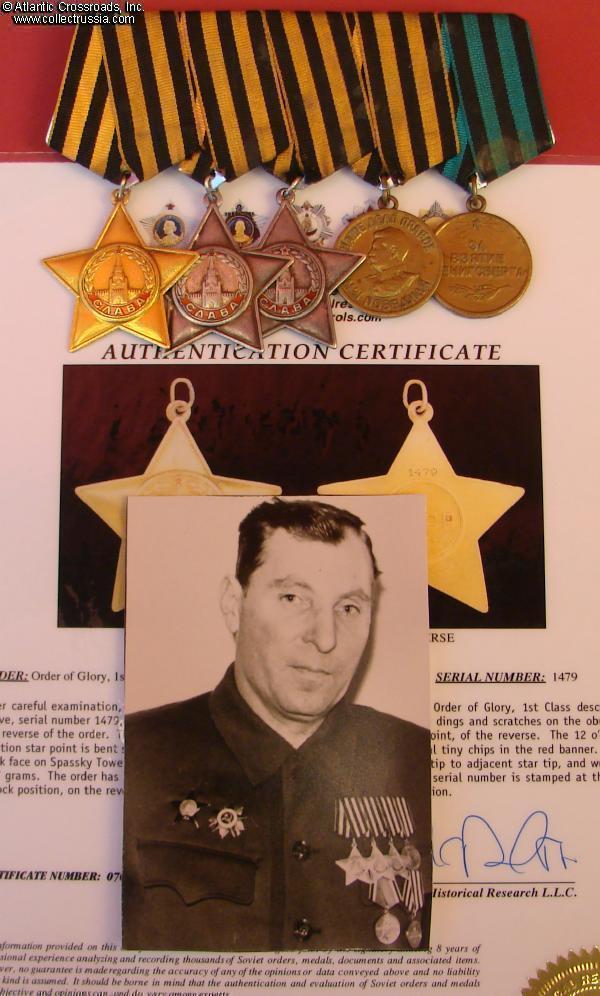
Group of Five Awards to Sergeant Aleksandr Borodin (Александр Михайлович Бородин), Reconnaissance Squad Commander, 183rd Separate Sapper Battalion, 1st Tank Corps.
Order of Glory, 1st cl., #1479. In gold and enamels; measures 48.8 mm in height (incl. eyelet), 46.8 mm in width; weighs 31.6 g not including the connecting link. Weighs 31.7 g not including the connecting link.
In excellent condition. The enamel is practically perfect and retains attractive luster, free of any wear visible to the unaided eye and has only a couple of contact marks that can barely be detected even under 10x magnification. The raised details of the center medallion including the Kremlin tower are overall very well preserved, having only a minimal amo
Order of Glory, 1st cl., #1479. In gold and enamels; measures 48.8 mm in height (incl. eyelet), 46.8 mm in width; weighs 31.6 g not including the connecting link. Weighs 31.7 g not including the connecting link.
In excellent condition. The enamel is practically perfect and retains attractive luster, free of any wear visible to the unaided eye and has only a couple of contact marks that can barely be detected even under 10x magnification. The raised details of the center medallion including the Kremlin tower are overall very well preserved, having only a minimal amount of wear to its highest points: even a couple of the numerals on the clock are still legible. The obverse of the arms is likewise well-preserved, showing only some minor dings. The reverse has minor edge knocks and a few scratches and scuffs to one the arms (at 7 o'clock viewed from the reverse) that may be a result of amateur testing for gold content and are not very detractive. The stippling is very nicely defined; the serial number is completely unaffected by wear. The order comes with a certificate of authentication by Paul McDaniel, the principal author of The Comprehensive Guide to Soviet Orders and Medals . The certificate shows a condition rating of 7 out of 10, quite high for an Order of Glory, 1st cl. made of relatively soft gold.
Order of Glory, 2nd cl, Type 2 ("thin" version), #5268 . Silver gilt, enamels; measures 47.2 mm wide and 1.2 to 1.6 mm thick at the tips of the arms (a distinguishing feature of the Type 2); weighs 19.6 g (medallion only). Note the low serial number #5268 (even for a Type 2).
In very fine to excellent condition. The enamel on the plaque has flaking, primarily along the edges, but no penetrating chips. There is a modest amount of wear to the raised points of the medallion, but most details are still nicely defined. A good amount of the original gilt is still present and clearly visible on the recessed parts of the medallion. Attractive, even patina to the arms and the reverse.
Order of Glory, 3rd cl., Type 2 Var. 1, #113358. Silver, enamels; measures 47.4 mm in height incl. eyelet, 46.5 mm wide; weighs 22.9 g not including the connecting link. In very fine condition. The enamel on the plaque and star has extensive flaking and surface chips, none of which penetrate to silver. Moderate wear to the center medallion and tips of the arms; the details of the medallion are relatively well defined nevertheless. Even dark patina to silver on both sides.
Medal for the Capture of Koenigsberg, Var. 1 (w. separate eyelet). In brass, 31.8 mm wide. Very fine to excellent condition; shows light, even wear and no significant flaws.
Medal for Victory over Germany, Var. 1 (w. separate eyelet). In brass, 32.3 mm wide. Very fine to excellent condition, matching that of the Koenigsberg Medal.
The decorations are mounted on a five-place aluminum suspension, apparently as once worn by the original owner. The ribbons are old, slightly soiled and worn at the bottom but sound and overall attractive. Note that although the two campaign medals are undocumented, they originally came with the group and are believed to have belonged to the same recipient.
Aleksandr Borodin was born in 1917, the year of the Russian Revolution, in a village near the town of Istra, Moscow region. He was conscripted into the Red Army in 1938 and in 1939-40, took part in the Winter War against Finland. He apparently remained on active duty leading to the Patriotic War as he was on the front lines from its first days. In December 1943, he received his first decoration, an Order of the Red Star. In 1944, Corp. Borodin served as combat engineer / reconnaissance man with the reconnaissance platoon of the 183rd Separate Sapper Battalion, 1st Tank Corps.
In early July 1944, during the late stages of the Soviet Bagration Offensive in Belorussia, the 1st Tank Corps spearheaded an attack of the 6th Guards Army deep into the German rear. At the time, Borodin was ordered to reconnoiter a river crossing, a task that had to be completed under an intensive enemy mortar fire. After discovering that the bridge had been blown up by the retreating Germans, he found a suitable location for a new bridge. The spot proved ideal, and the bridge was soon completed by his unit's engineers. Borodin then on his own volition took part in an assault on a nearby village occupied by the enemy. After helping to capture the village, he found and marked two usable fords over another river. Borodin was subsequently recommended for the Order of the Patriotic War, 2nd cl. by his battalion commander, The Commander of the 1st Tank Corps Lt. General Butkov however downgraded the recommended award to the Order of Glory 3rd cl. which bestowed upon Borodin on 19 July 1944.
Borodin earned his second Order of Glory during the October 1-13, 1944 offensive conducted by the 2nd Guards Army toward Memel (Klaipeda), a strategically important Baltic seaport in Lithuania. On 6 October, Corp. Borodin under enemy fire found a ford and undamaged bridge over the Krozhenta River (the name of the river is as transliterated in the subsequent award recommendation) near the settlement of Kelmy. The information he provided allowed the tanks of the 1st Tank Corps, then a part of the 2nd Guards Army, to successfully cross the river. Two days later, Borodin found a ford of the Jūra River (tributary of the Neman) and then got on the enemy-held bank where he single-handedly and having no special equipment deactivated 30 antitank mines. He thus cleared the path for his unit's self-propelled guns and allowed them to press the offensive. For his outstanding contribution to the success of the operation, Borodin was awarded with the Order of Glory, 2nd cl. on 19 November 1944.
In early April 1945, the 1st Tank Corps took part in the storming of Koenigsberg as a part of the 50th Army. By that time, Borodin had been promoted to Sergeant and become a recon squad leader. Over the course of the battle, a makeshift bridge Soviet sappers had laid over an antitank ditch was blown up by a direct hit. As a result, a column of tanks and assault guns of the 1st Tank Corps got stalled and came under murderous direct fire of German heavy artillery. Borodin and two other soldiers were given the urgent assignment to reconnoiter the condition of the bridge. Although both of his comrades soon fell wounded, Borodin not only successfully completed his mission alone, but also carried one of the wounded back to the Soviet lines. Thanks to the information he provided, the bridge was soon repaired and the Soviet armor rolled on. Immediately after the conclusion of the battle for Koenigsberg on 9 April 1945, Borodin was recommended for the Order of Glory 1st cl. by his battalion commander. Given the high level of award, it took an unusually short time, only until 29 June 1945, for the recommendation to pass through the chain of command and get officially approved by the Supreme Soviet. Borodin thus became one of the very few Soviet soldiers to receive the Order of Glory, 1st cl. so soon after the victory in Europe and prior to the end of WW2.
Research Materials: Xerox copy and English translation of the award record card and commendations for the Order of Glory 1st and 2nd
cl., copy of the commendation for the Order of Glory, 3rd cl., with a partial (hand-written) English translation; copy of the special
archival card of a Full Cavalier of the Order of Glory (contains a very nice post-war photo of Borodin wearing his decorations on a civilian
suite), Xerox copy of the article about him in the catalog Cavaliers of All Three Classes of the Order of Glory (contains his
photo). Ample information on the 1st Tank Corps can be found in the Volume II School of Battle. Soviet Tank Corps and Tank Brigades,
January 1942 to 1945 of Charles Sharp's series Soviet Order of Battle, WW 2.
$19,000.00 Add to cart

